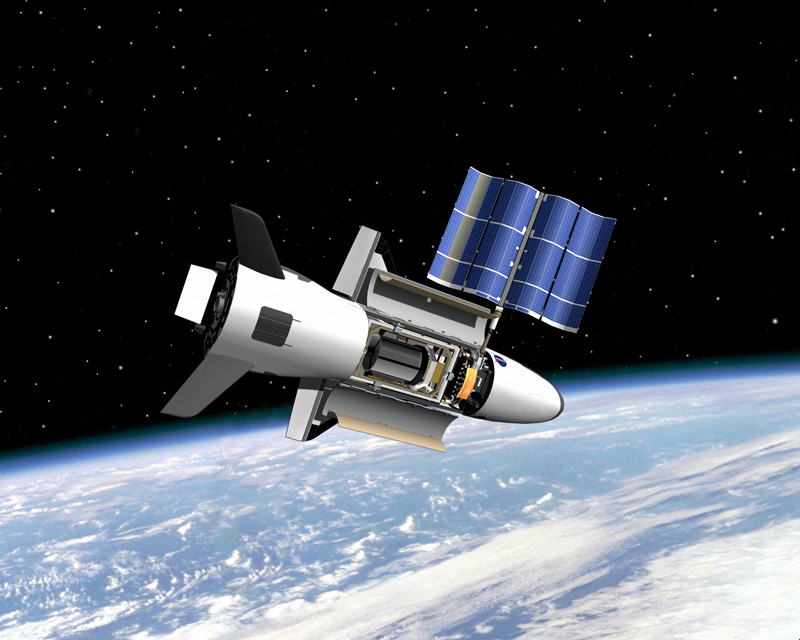Air Force's Secretive Space Plane Nears Maiden Voyage

You would think that an unpiloted space plane built to rocket spaceward from Florida atop an Atlas booster, circle the planet for an extended time, then land on autopilot on a California runway would be big news. But for the U.S. Air Force X-37Bproject ? seemingly, mum?s the word.
There is anair of vagueness regarding next year?s Atlas Evolved Expendable launch of the unpiloted, reusable military spaceplane. The X-37B will be cocooned within the Atlas rocket?s launch shroud ? aride that?s far from cheap.
While thelaunch range approval is still forthcoming, SPACE.com has learned thatthe U.S. Air Force has the X-37B manifested for an April 2010liftoff.
As amini-space plane, this Boeing Phantom Works craft has been under developmentfor years. Several agencies have been involved in the effort, NASA as well asthe Defense Advanced Research Projects Agency (DARPA) and various arms of theU.S. Air Force.
Over the lastfew months, I?ve been in touch with DARPA, Boeing, the Pentagon, the U.S. AirForce Space Command, as well as NASA itself. Either you get a ?not in ourportfolio? or are given a ?go to? pass to another agency. Just a few weeks ago, Ieven commandeered a face-to-face ?no comment? from a top Pentagon official forAir Force space programs about X-37B.
Tight-lippedfactor
Thetight-lipped factor surrounding the space plane, its mission, and who is incharge is curious. Such a hush-hush factor seems to mimic in pattern that mysterycommunications spacecraft lofted last month aboard an Atlas 5 rocket, simplycalled PAN. Its assignment and what agency owns it remains undisclosed.
Get the Space.com Newsletter
Breaking space news, the latest updates on rocket launches, skywatching events and more!
But in abrief burst of light eking from the new era of government transparency, I didscore this comment from NASA.
While theprogram is now under the U.S. Air Force, NASA is looking forward to receivingdata from the advanced technology work.
?NASA has along history of involvement with the X-37 program. We continue to monitor andshare information on technology developments,? said Gary Wentz, chief engineerScience and Missions Systems Office at the NASA Marshall Space Flight Center. ?Weare looking forward to a successful first flight and to receiving data fromsome advanced technologies of interest to us, such as thermal protectionsystems, guidance, navigation and control, and materials for autonomousre-entry and landing.?
The vehicleitself is about 29 feet long with a roughly 15-foot wingspan and weighs in atover five tons at liftoff.? Speeding down from space, the craft would likelymake use of Runway 12/30 ? 15,000 feet long by 200feet wide ? at Vandenberg Air Force Base inCalifornia.
Vandenberg servesas an emergency space shuttle landing strip, as a second backup afterCalifornia?s Edwards Air Force Base ? which has also been noted as a landingspot for the X-37B.
Once inorbit, what such a vehicle might enable depends on the eye of the beholder.Intelligence gathering, kicking off small satellites, testing space gear arefeasible duties, as is developing reusable space vehicle technologies.
Spacetest platform
Just lastmonth, a U.S. Air Force fact sheet noted that the Air Force Rapid CapabilitiesOffice (RCO), located in Washington, D.C. ?is working on the X-37B Orbital TestVehicle to demonstrate a reliable, reusable, unmannedspace test platform for the United States Air Force.?
The missionof the RCO is to expedite development and fielding of select Department ofDefense combat support and weapon systems by leveraging defense-wide technologydevelopment efforts and existing operational capabilities.
?Theproblem with it [X37-B] is whether you see it as a weapons platform,? saidTheresa Hitchens, former head of the Center for Defense Information?sSpace Security Program, now Director of the United Nations Institute for Disarmament Research (UNIDIR) in Geneva, Switzerland.
?It thenbecomes, if I am not mistaken, a Global Strike platform. There are a lot of reasonsto be concerned about Global Strike as a concept,? Hitchens told SPACE.com.
The implications of the program as apossible space weapon are surely not lost on potential U.S. competitors,Hitchens said, who may well seeanti-satellites (ASATs) as a leveler.
?Would this thing be vulnerable toASATs? Yes, if it stayed on orbit any length of time,? Hitchens added. ?While Isee value of such a platform as a pop-up reconnaissance or even communicationsplatform, if weaponized it becomes yet another reason for other nations to considerbuilding dangerous ASATs,? she cautioned.
Anothermission question is, to what extent the X-37B might play into the recentannouncement that NASA is partnering with the U.S. Air Force ResearchLaboratory to develop a technology roadmap for the commercial reusable launchvehicle, or RLV, industry.
All thatsaid, and after years in the making, the X-37B is approaching its firstglobe-trotting, milestone making and historic flight ? that much is known.
- Video - Spaceplane Skylon: A British Ride to Space
- Video - Successful Satellite Kill
- SPACE.com Video Show - NewSpace: The Orbital Industrial Revolution
Leonard David has been reporting on the space industry formore than four decades. He is past editor-in-chief of the National SpaceSociety's Ad Astra and Space World magazines and has written for SPACE.comsince 1999.
Join our Space Forums to keep talking space on the latest missions, night sky and more! And if you have a news tip, correction or comment, let us know at: community@space.com.

Leonard David is an award-winning space journalist who has been reporting on space activities for more than 50 years. Currently writing as Space.com's Space Insider Columnist among his other projects, Leonard has authored numerous books on space exploration, Mars missions and more, with his latest being "Moon Rush: The New Space Race" published in 2019 by National Geographic. He also wrote "Mars: Our Future on the Red Planet" released in 2016 by National Geographic. Leonard has served as a correspondent for SpaceNews, Scientific American and Aerospace America for the AIAA. He has received many awards, including the first Ordway Award for Sustained Excellence in Spaceflight History in 2015 at the AAS Wernher von Braun Memorial Symposium. You can find out Leonard's latest project at his website and on Twitter.









